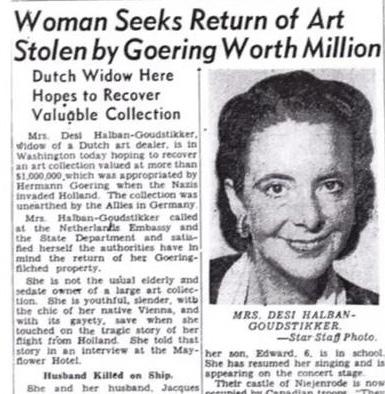Above: Renee and her brother Michael on the boat to the United States in January 1947 (photo on display at the Holocaust Museum).
She was constantly beaten at the camp. However, she said she would never give the Pincus and Renee cutting their wedding cake on November 1, 1953 at the Francis Marion Hotel in Charleston. soldiers the satisfaction of seeing her cry. The hunger, humiliation, and dehumanization were awful, and the only times she was happy was when the camp was bombed. But her mother kept her morale up, and gave her a reason to live. At one point, my mother suffered from y mother, Renee Kolender, was cheeks, and use the gloves as bows for their typhoid fever. She refused to go to the infirborn in 1922, in Kozienice, Poland, hair, to brighten their appearance and make mary, having heard too many stories about the daughter of Moishe, a CPA, them appear healthier. patients never returning from there. Luckily, and Rose Fuchs. She claimed to be “spoiled They also dressed my mother’s younger she recovered. Unfortunately, however, just rotten,” as the only girl of three children, brother, Michael, who was only 9 years old, before the end of the war, her mother died. A and enjoyed a nice childhood, at least until as a girl, to allow him to stay in their camp. kind soldier allowed my mother to go to the September 1, 1939, her 17th birthday, when Otherwise, he would have been separated burial. On the back of a picture of her and the Nazis invaded Poland. That was the end from them, and surely sent to his death. If her mother, she drew a map outlining the of school, the “end of everything.” Her family my mother and grandmother’s ploy had steps from the camp to the grave. was then moved to her grandparents’ house been discovered, they would have been My mother and her brother were liberin the ghetto. shot immediately. ated in Czestochowa by American soldiers Her father and older brother, in 1945. Being the only survivors in Yitzchak, were murdered early their family, they had nowhere to in the war. In 1943, she and her go, as their house in Kozienice had mother were sent to a munitions been taken over by local residents. factory in Czestochowa, Poland, as She wrote a letter to an uncle slave laborers. For her daily work, and aunt, Otto and Sarah Fox, in she was given red crayons (to be Charleston, asking for help. (Family used as markers for the ammunilore has it that the envelope was tion) and rubber gloves, which she addressed to “Otto Fox, Charleston, would keep at the end of the day. S.C.”) Otto contacted Congressman On occasion, the camp doctors Mendel Rivers, who helped pave would examine the prisoners, with the way for my mother and her those prisoners deemed unhealthy brother to get into the U.S. in 1947. to be sent to their deaths. On those In Charleston, she worked days, my mother and her mother at her uncle’s store, Fox Music would use the crayons both as House, until she married my father, Renee Kolender’s (née Fuchs) father’s family, the Fuchs (changed to Fox lipstick and to add color to their Pincus Kolender, also a Holocaust in the U.S.). Photo taken in Koszenica, Poland, ca. 1925-26.
My Mother — Renee Kolender
M
Supplement created and paid for by the SOUTH CAROLINA COUNCIL ON THE HOLOCAUST | APRIL 27, 2022
survivor. They had three children and six grandchildren. That, she said, was their biggest victory, and their greatest joy. They survived and flourished, and the Nazis are but a horrific historical footnote. My mother’s brother, Michael Fox, went to the Citadel, married Janice Kramer, and soon thereafter moved to Janice’s hometown, Wallace, North Carolina. He became a successful businessman, and also had three children and six grandchildren. It was difficult for my mother to talk about the war. In 1987, our extended family went on an emotional trip to Poland. It was on that trip that I learned many things about my mother’s past, most notably how her family members were killed. We went to the location of the munitions factory in Czestochowa. Using the (still legible) map she drew in 1945 on the back of the picture of her mother, we tried to retrace the steps to find where her mother was buried. While we did not find the exact location, it allowed us to recite Kaddish (the Jewish prayer for deceased family members) for my grandmother, which my mother and uncle were unable to do at the time of their mother’s death, giving them much comfort after all these years. My mother said life straightens itself out. She taught my siblings and me compassion and the importance of family. Most importantly, she wanted a better life for her children. And she certainly succeeded in that. ■ Jeff Kolender is a Maryland attorney and son of Holocaust Survivors.
| HOLOCAUST REMEMBERED
9




















